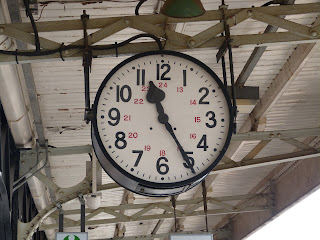This is the former church of St Nicholas on The Cross. Built in 1730 - 35, it became redundant in 1989 and is now a branch of Slug and Lettuce.
To it s credit, the new occupier's marks are quite minimal on the facade, helped no doubt by the building's Grade II listing.
A clock that is more hidden away is this one in Reindeer Court, illustrating the fact that to find all of the clocks you have to walk all of the streets.
The buildings date from the 16th century, with later additions and alterations. Originally a shop with house and stable, it became an inn and is now a series of shops.
The Fownes Hotel stands on City Walls Road, which is the A38 dual carriageway running alongside, yes you guessed it, the city walls.
This huge building was constructed in 1882 - 83 for the manufacture of gloves. A one-time key local industry, there were once 150 glove works in the city. Production at this site closed in 1973, and in 1985 it was transformed into a hotel.
Construction of Worcester Cathedral began in 1084. The clock inside is a bit more recent, dating from 1869. It was manufactured by Joyce of Whitchurch.
Just four more clocks in Worcester to visit (although as always if you know of any others that I haven't covered please let me know). First of the quartet is a nice modern clock on the St Dunstan's building of the Heart of Worcestershire College on The Butts.
I am always a fine of this simplistic style of clock when it is set on a modern plain building. It is also set such that it can be seen from a long distance and from many viewpoints, something which can be missing from many recent installations.
More traditional in style is this example at St Clements on Henwick Road. The church was completed in 1823, with an extension in 1879.
There is often a surprise clock in every town and city that you visit. Just when you think you have covered every possible example in the central area, you look up and see one that you must have walked passed several times already or you walk along a street that you have somehow avoided to date. Such a moment at Worcester came at the Crowngate Shopping Centre at its Broad Street entrance.
Lurking inside is a modern, minimalist clock - just two hands and four dashes.
And so finally we arrive at the railway station (Shrub Hill that is) to take the train home.
Here we have a good old no-nonsense railway clock, with Arabic numerals and the 24 hour system also indicated. There is no excuse for missing your train, whether it is at 11.25 or 23.25 hrs.















































No comments:
Post a Comment